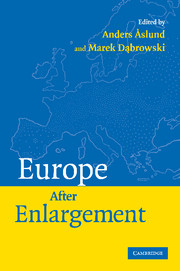Book contents
- Frontmatter
- Contents
- List of Charts, Tables, and Boxes
- Contributors
- Acknowledgments
- Introduction
- 1 Has Europe Lost Its Heart?
- 2 Economic Implications of the Social Provisions of the Stalled EU Constitution
- 3 Fiscal Policy and Fiscal Rules in the European Union
- 4 Design and Implementation of the Stability and Growth Pact: The Perspective of New Member States
- 5 Perspectives on the Lisbon Strategy: How to Increase European Competitiveness
- 6 Is Europe Reforming? Evidence from Cross-Country Structural Indicators
- 7 Recovery Growth as a Stage of Post-Socialist Transition
- 8 Comparative Oligarchy: Russia, Ukraine, and the United States
- 9 The Economic Rationale of the “European Neighbourhood Policy”
- 10 Economic Integration of Eurasia: Opportunities and Challenges of Global Significance
- Index
- References
10 - Economic Integration of Eurasia: Opportunities and Challenges of Global Significance
Published online by Cambridge University Press: 04 December 2009
- Frontmatter
- Contents
- List of Charts, Tables, and Boxes
- Contributors
- Acknowledgments
- Introduction
- 1 Has Europe Lost Its Heart?
- 2 Economic Implications of the Social Provisions of the Stalled EU Constitution
- 3 Fiscal Policy and Fiscal Rules in the European Union
- 4 Design and Implementation of the Stability and Growth Pact: The Perspective of New Member States
- 5 Perspectives on the Lisbon Strategy: How to Increase European Competitiveness
- 6 Is Europe Reforming? Evidence from Cross-Country Structural Indicators
- 7 Recovery Growth as a Stage of Post-Socialist Transition
- 8 Comparative Oligarchy: Russia, Ukraine, and the United States
- 9 The Economic Rationale of the “European Neighbourhood Policy”
- 10 Economic Integration of Eurasia: Opportunities and Challenges of Global Significance
- Index
- References
Summary
The collapse of the Soviet Empire in 1991 opened a new frontier in globalization: the economic integration of the Eurasian “super-continent.” This chapter explores the process and prospects of integration on the huge land mass that stretches from the Atlantic to the Pacific and from the Arctic Sea to the Indian Ocean, principally focusing on the economic dimensions of the integration process in Eurasia. It compiles evidence on integration in the areas of energy and non-energy trade and transport, illicit drug trade, investment and capital flows, migration, and communication and knowledge. It concludes with a consideration of the institutional and political dimensions that affect regional cooperation in Eurasia and offers some broad policy recommendations.
The Eurasian continental space was integrated for centuries, if not millennia, of pre-modern history. Anthropologists speculate that much of modern humanity originated in and spread from the Mongolian steppes millions of years ago. Waves of conquerors, among them Attila the Hun and Genghis Khan, followed these early migrations. The Great Silk Road (represented in a stylized manner in Chart 10.1) serves as the epitome of Eurasian economic and cultural connectedness. It ran east to west from the Yellow Sea through Central Asia, the Mediterranean, and on to Western Europe. The route also connected the Indian subcontinent and what are now the northern reaches of Russia (Hopkirk, 1980). Commerce, culture, and religion spread along this route, as did conflict and disease, including the Black Death of the mid-fourteenth century.
- Type
- Chapter
- Information
- Europe after Enlargement , pp. 189 - 232Publisher: Cambridge University PressPrint publication year: 2007
References
- 2
- Cited by



